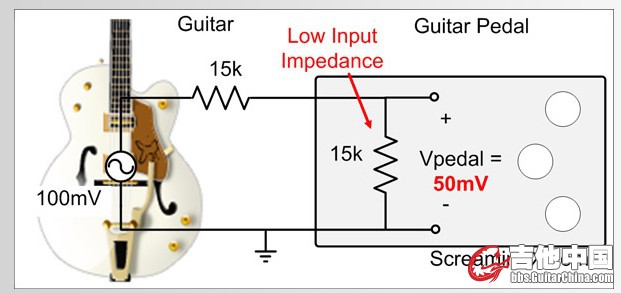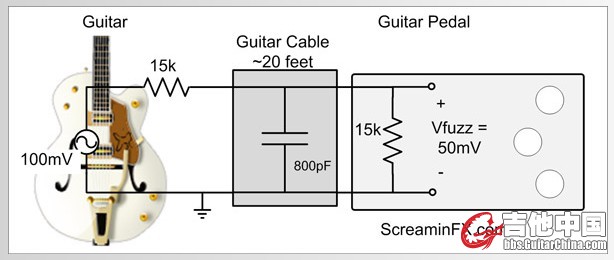|
|
 发表于 2013-3-24 23:16:51
|
显示全部楼层
发表于 2013-3-24 23:16:51
|
显示全部楼层



Guitar connected to 20 foot cable into a pedal with low input impedance. The DC signal at the pedal would be 50mV and the signal at 10kHz would only be 36mV. As the frequency of your signal goes up, you lose more tone.
The problem is that this capacitor also adds an impedance; which depending on the frequency, can be very low. This is the problem that makes you lose higher frequency components of your sound. In fact, as frequency goes up, impedance goes down for a capacitor (guitar cable) and you lose more of your high frequency guitar signal. The impedance of a capacitor can be written as:
Zcap = 1/(2*pi*f*C) where f is the frequency.
Because frequency (f) is in the bottom, as it goes up the impedance Z goes down. You can hear up to about 20kHz, so lets run an example at half this. What if your guitar outputs a 10kHz signal into a 20 foot cable? The impedance is (use 10k for frequency and 800pF for Capacitance):
Zcap = 1/(2*pi*f*C) = 1/(2*3.14*10,000Hz*800pF) = 20kOhms
This is kind of low for an input impedance so lets look at what happens at 10KHz when we have this cable connected from the guitar to that low input impedance of 15k.Figure 4 shows the circuit, where we can analyze it for 10kHz.First, simplify the input impedance of the fuzz face and the cable impedance using a parallel network. The input 10k of the pedal is in parallel with the 800pF capacitance of the cable and two impedance in parallel have total impedance (Z1*Z2) / (Z1 + Z2) so:
Rcableandpedal = (Rin * Zcap) / (Rin + Zcap) = (15k * 20k) / (15k + 20k) = 8.57kOhm
This means that the guitar output sees an impedance of only 8.57kOhm at 10kHz when you connect the guitar to the pedal with a 20foot cable. We can find the signal at the pedal input by using our resistor divider network and guitar output impedance, we get:
Vpedal = Vguitar* (Rcableandpedal / (Rout +Rcableandpedal)= 100mV * (8.57k / (8.57k + 15k) = 0.36*100mV = 36mV
Because you connected the fairly long cable, you lose even more of the actual signal and it doesn’t appear across the input of the pedal. You are now losing a good amount of the signal from those expensive pickups you bought. . . The story gets better for low frequencies, but worse for higher frequencies. This configuration is called a low pass filter, because low frequency signals pass through but higher frequencies do not. You really don’t want this if you want to preserve the fidelity of your original guitar pickup signal.
Question time, where is it better to put a guitar buffer, before or after a long cable? The answer is before. The reason is that if you have a low impedance of the capacitance of the cable then it is in parallel with the input impedance of whatever is after it (remember from before). So, even if you have that high impedance guitar buffer, effectively the impedance is low and you will lose your signal. But, if you have the guitar buffer pedal before the cable, then the low output impedance of the buffer will be able to drive the cable and the input resistance of the next pedal or amp in the line.
Conclusion:Two main culprits of sound loss are the capacitance of your guitar cables and a low or non ideal input impedance of guitar pedals in your chain. If you add a guitar buffer in between, you can more easily drive these two situations and preserve your tone across all the frequency range your guitar produces. When you start using a buffer, you will immediately notice that you tone sounds a lot “brighter” or has more “sparkle”. |
|
